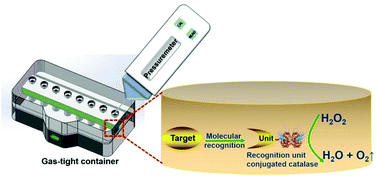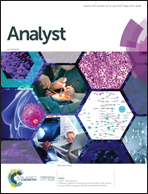Catalase-linked immunosorbent pressure assay for portable quantitative analysis†
Abstract
In this study, catalase-linked immunosorbent pressure assay with a gas-generation reaction was established for quantitative detection of disease biomarker C-reactive protein (CRP) by a portable pressuremeter. The pressure-based detection system recognizes, transduces, and amplifies the target signal to a convenient target-correlated pressure signal reading in a closed chamber. Biotin molecules were modified on the surface of catalase in order to incorporate catalase into the pressure immunoassay by the streptavidin–biotin interaction. To improve the assay performance, the modification ratios of biotin molecules to catalase, and the concentrations of capture and detection antibodies were further optimized. The catalase-linked immunosorbent pressure assay allows portable and quantitation analysis of CRP with a limit of detection of 1.8 nM, which can satisfy the clinical needs for determining the risk of cardiovascular disease. The catalase-linked immunosorbent pressure assay also shows superior specificity and good accuracy. Compared to the previously reported assay catalyzed by PtNP nanozyme, catalase is not easily deactivated during storage and operation. With the merits of enzymatic efficiency, biocompatibility, low non-specific adsorption and facile modification, catalase can be reasonably used for reproducible, stable, simple quantitative detection of disease markers using a portable pressure-based assay in resource-limited settings.

- This article is part of the themed collection: Analyst Recent HOT articles


 Please wait while we load your content...
Please wait while we load your content...